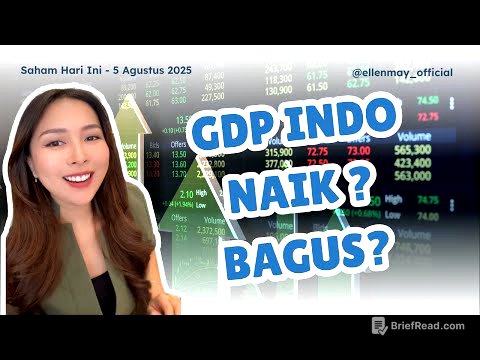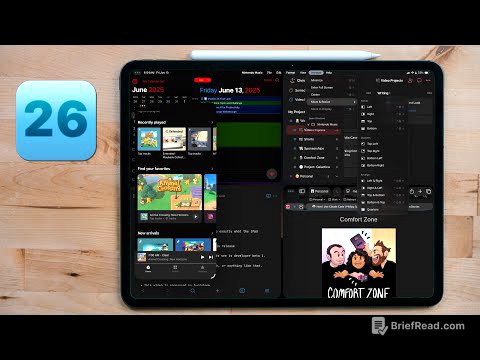TLDR;
This video explains the 10EMA strategy, a trend-following technique using the 10-period Exponential Moving Average (EMA). It's designed to identify entry and exit points in the market, applicable across different time frames and instruments like stocks, options, and futures. The strategy focuses on spotting trigger candles that signal potential trend reversals and provides guidelines for setting stop losses and profit targets.
- The 10EMA strategy is versatile and can be applied to various financial instruments and timeframes.
- Key elements include identifying trigger candles, setting stop losses at the 10EMA line, and aiming for a 1:2 risk-reward ratio initially.
- The strategy incorporates techniques for trailing stop losses to maximize profits while managing risk.
Introduction to the 10EMA Strategy [0:01]
The video introduces the 10EMA strategy, which utilizes the 10-period Exponential Moving Average to identify and follow market trends. Anand Lada has been using and backtesting this strategy for a long time, and now it is showing great results in the live market. The strategy is designed to be simple to learn and execute, making it suitable for traders looking to profit by following market trends. The presenters emphasize that the strategy can be applied across various charts and time frames, including international markets and different financial instruments.
Understanding 10EMA: Basics and Application [2:34]
The core of the strategy revolves around understanding the 10EMA, which calculates the average price of an asset over the last 10 periods, giving more weight to recent prices. This helps in identifying the current trend; prices above the 10EMA suggest a bullish trend, while prices below indicate a bearish trend. The video explains the difference between Simple Moving Average (SMA) and Exponential Moving Average (EMA), highlighting that EMA gives more importance to recent price movements.
Identifying Trigger Candles and Setting Entry/Exit Points [4:28]
A key component of the 10EMA strategy is identifying "trigger candles," which signal potential trend reversals. In a bullish trend, a red candle that doesn't touch the 10EMA line is considered a trigger. If the high of this red candle is subsequently broken by the next candle, it signals a continuation of the bullish trend, providing an entry point. The stop loss is set at the 10EMA line below the trigger candle, and the initial target is a 1:2 risk-reward ratio.
Trailing Stop Losses: Techniques for Profit Maximization [7:22]
The video discusses various methods for trailing stop losses to protect profits and maximize gains. The simplest method involves trailing the stop loss along the 10EMA line, adjusting it as the line moves. More advanced traders can use Average True Range (ATR) to set trailing stop losses, typically at 2 or 3 ATR levels. The presenter also touches on using the previous candle's low as a reference for setting the stop loss.
Short Trade Setup: Reversing the Strategy for Bearish Trends [9:37]
The strategy is reversed for short trades in a bearish trend. When the stock is in a bearish trend below the 10-day limit, a green candle appears, which indicates that the stock is trying to rise. If the low of this green candle is cut, it triggers a short entry. The stop loss is placed at the high of the green candle, and the initial target is a 1:2 risk-reward ratio, with a maximum of 1:5.
Live Market Example: Applying the 10EMA Strategy [12:39]
The presenters provide a live market example using a 5-minute intraday chart to illustrate the 10EMA strategy. They identify a short trade where the price is below the 10EMA, a green trigger candle forms, and the low of the candle is broken, signaling a short entry. They also explain how to trail the stop loss and highlight the potential for a 1:3 or 1:4 risk-reward ratio.
Options and Futures Trading with 10EMA [17:15]
The video explains how to apply the 10EMA strategy to options and futures trading. For futures, traders can directly short the futures contract. In option selling, traders can sell call options at the level of the 10EMA stop loss, which can provide a good risk-reward ratio. For option buying, traders enter a buy position when the trigger is hit and exit when a 1:2 risk-reward ratio is achieved.
Long Trade Example and Strategy Validation [19:23]
Another example is presented, showcasing a long trade where candles are forming above the 10EMA, indicating an uptrend. A red candle appears, signaling a potential reversal, and if the high of this candle is broken, a buy entry is triggered. The presenters emphasize the importance of paper trading and testing the strategy before using real capital.
Applying 10EMA on a Daily Time Frame [23:30]
The video transitions to demonstrating the 10EMA strategy on a daily time frame, highlighting its effectiveness for longer-term trades. The presenters explain that selling put options out-of-the-money can be particularly effective on a daily time frame, offering substantial profit potential. They also caution that while intraday trading can offer quick gains, it requires a higher level of risk management and emotional control.
Final Thoughts and Additional Resources [26:03]
The video concludes by summarizing the 10EMA strategy and encouraging viewers to wait for specific market conditions, such as the formation of a red candle, before making further trades. The presenters also mention a special course offering more advanced strategies and backtested results, inviting viewers to inquire for more details. They emphasize the importance of subscribing to the channel and staying tuned for future videos.









